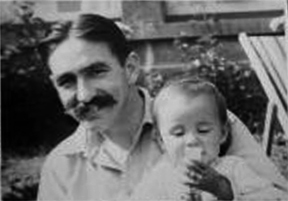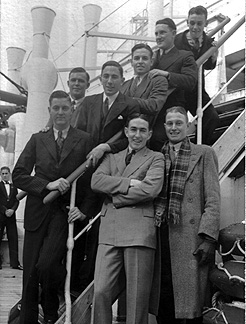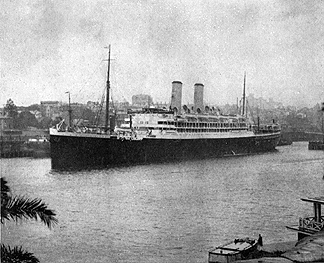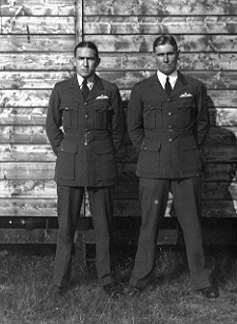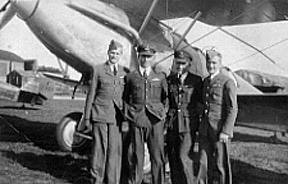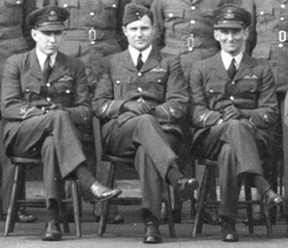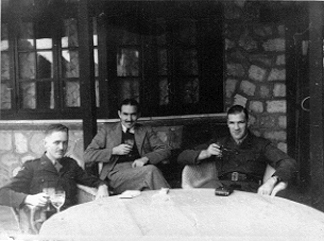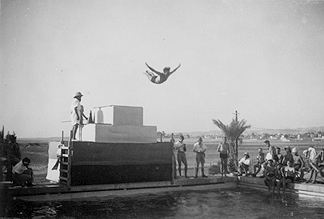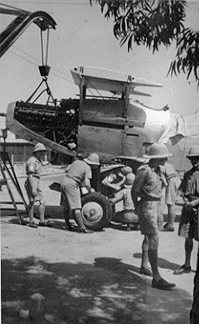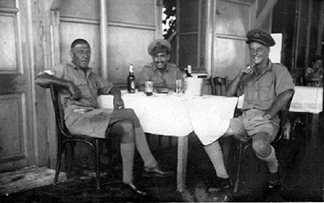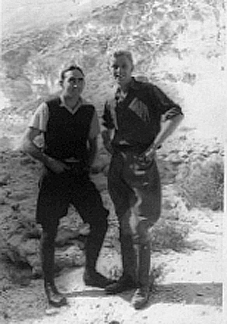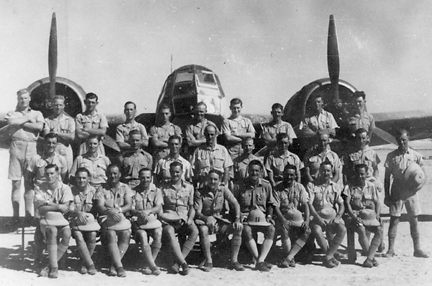 |
 |
|||||||||||||
|
Flight Lieutenant Allan Leonard Farrington 40046 RAF KIA 29 August 1944 Of British origin, the senior Farringtons were living in New Zealand when Cyril Horley Farrington was born in 1885. By about 1905 or 1906 Cyril had moved to Australia, to work for a firm of produce merchants in New South Wales country towns like Cobar, where he met and married Ellie Kinley in 1909. The couple later settled in Young, a country town 100 miles North-West of Canberra, famous for its gold-mining past, its 1885 heritage-listed railway station and, since the 1920s, its cherry harvest. There, Allan Leonard Farrington (“Tup”, “Dinkum” or even “Dinky”, but never, ever "Al") was born on 26 February 1915. By about 1920, the Farringtons had moved to the Northern Beaches area of Sydney: Manly, Fairlight and Balgowlah. In Whistler St Manly the family owned a hardware, horse-feed and provisions business until the late 1940s.
John was born to Alison and Allan on 2 July 1942 in the United Kingdom From 1927 to 1933, young Allan Farrington attended Sydney Technical High School, a ferry and tram-ride away across the harbour and through the City to Paddington. Originally, the High School had occupied Ultimo House within the Sydney Technical College campus, before moving to Albion House, Paddington, in 1925. Since 1956, the High School has occupied its present site at Bexley. Sydney Technical College still operates at the Ultimo site, if much changed in organisation and title. It was at High School that he first met Bill Edwards, the two becoming good friends. In civil life an electrical fitter, Farrington was also an enthusiastic sportsman who enjoyed riding, rugby football and competition diving. He was particularly successful at diving, representing NSW from 1932 to 1936 and competing at international level in NSW summer events in 1935. From 1933 he was serving in 1 Corps Signals, Australian Corps of Signals. On his application for an RAAF cadetship in July 1935, the Adjutant wrote Corporal Farrington a cracker of a reference: "This NCO is a very good type and during the period of his service has always been efficient." RAAF Point Cook cadet It is not entirely clear today when the system made the RAAF vs RAF selection. Some accounts hint that it was at the start of a course, while other records and accounts imply that it was at the end: perhaps the more practical approach from either side. By the mid 1930s the RAAF was entering a period of modest and accelerating expansion. Part of the impetus for growth came from Britain, seeking many more Australian pilots for the RAF under the existing RAAF/RAF exchange scheme. To meet this need, in 1936 the 1 FTS Point Cook intake of cadet pilots was effectively doubled by starting two courses, one beginning in January, the second in July, the 1936 ‘A’ Course. Perhaps prevented by time from making the January entry, Allan Farrington was accepted into the July course, along with his mate Bill Edwards. Both cadets were awarded their wings a year later on 29 June 1937. Selected for RAF short service commissions, they embarked with 11 other Point Cook graduates for the United Kingdom on 17 July 1937 aboard the passenger liner RMS Orama.
A significant event, the family arranged for a print from the Sydney Morning Herald, whose brief article had appeared on the following Monday. The Herald’s caption read "Some of the thirteen newly-trained officers of the Royal Australian Air Force who sailed for England by the Orama to take up short-service commissions in the RAF. From left (in front) AL Farrington and JT Lewis; (at rear) JF McKinlay, AR Gibbes, JW Layton (sic: JWE Leighton), DH Hunter, CH Fry and AR Mulligan".
The 20,000 ton Orient Line vessel was well known on the England—Australia run. Built in 1924, she took pride of place in the company booklet Orient Line to England of 1928. Converted to operate as a troopship in 1940, Orama was torpedoed by the Admiral Hipper on 8 June 1940. She sank 300 miles off Norway while returning, light, from the Narvik affair in which the aircraft carrier HMS Glorious and its escort destroyers HMS Ardent and HMS Acasta were sunk with heavy loss. The Oramas were rather luckier: although 19 were lost, 280 of the crew were picked up by the Germans, albeit PoW for the duration. RAF life But first, with an abundance of caution, the RAF promptly sent its new Pilot Officers from Australia back to school. Barely a week after marching into the Depot (RAF Uxbridge) on 26 August 1937, Farrington was posted to 8 FTS Montrose. At least it was to the Advanced Flying course and of just seven weeks duration, ending on 27 November. Most likely he was flying the Hawker Harts there, rather than the Avro Tutor elementary trainers. By some miracle of RAF stiffness at 8 FTS they managed, just, to fail Allan Farrington on marks even while according him that rare assessment, above average, not only in armament and navigation but also as pilot. To cap it off, having carefully noted that he had qualified for the award of the Flying Badge (his “wings”) in the RAAF on 29 June 1937, the RAF now authorised him to wear the badge, with effect from the original date. Well. Some neck, as Churchill later said in a more feisty context. Still, when the RAF moved, they moved quickly and Farrington was posted to 211 (Bomber) Squadron that same day, 27 November. On the other side of the world, Nanking was about to be besieged by Japanese forces. In Europe, Italy was about to walk out of the League of Nations.
“He is another Aussie from SA”. Both men in their darker RAAF blues, the scene (dress, hut, and weather) looking very pre-war RAF Home station. Both graduates of the July 1936 ‘A’ Cadet Course at RAAF Point Cook, commissioned in the RAF under the exchange scheme. This formal pose is interesting: it hints that the occasion might, possibly, have been on passing out of 8 FTS Montrose on 27 November 1938, duly authorised to wear their wings.
Caption: ALF. Bungey, centre left, Farrington centre right. With wings. Farrington remarked that the other two, Anderson (left) and Moreland (right), had joined the RAF directly (as their lighter RAF blues confirm). From the late 1930s on into 1940, men from around the Commonwealth took a punt and travelled to Britain in hope of gaining an RAF commission. Many succeeded. The aircraft is a Hart Trainer (long exhaust, tandem cockpits) which may place this shot to Montrose, Autumn or Winter 1937. In the bitter air campaign of May 1940 in France, Bob Bungey in 226 Squadron was one of the few to survive in Fairey Battles against the Luftwaffe. His mate Doug Cameron, the fourth Point Cook man of 211 Squadron, was not so lucky. Soon after returning to the UK, Bob Bungey became engaged to Sybil Ellen Johnson of Wallingford in Berkshire. When the chance to transfer to Fighter Command came in August, he took it. Posted first to 79 Squadron, on 19 September 1940 he moved to 145 Squadron, another Hurricane unit, as F/Lt. On 7 November Bungey was shot down near the Isle of Wight in Hurricane I V6889. Slightly wounded, he and and his damaged aircraft were both recovered and he returned to his Squadron. In March 1941 Bungey was posted to 452 Squadron RAAF, flying the Supermarine Spitfire IIA. Highly regarded, he was made temporary Squadron Leader commanding the Squadron in July 1941. Early in October, he and Sybil were married. Awarded the DFC in that month, he led his Squadron with elan until deservedly posted to RAF Shoreham as Station Commander in late January 1942. He had by then scored five victories. Promoted Squadron Leader (war substantive) in May (London Gazette 21 August), he moved to station commander at RAF Hawkinge, perhaps as acting Wing Commander, before his return Australia and the RAAF. The Australian official history noted: “The meteoric rise to prominence of No. 452 owed much...to the complete confidence which the pilots placed in Bungey’s training and administrative leadership.” Rightly screened after a very successful tour of duty and with his RAF SSC about to conclude, Bungey was to return home after some 6 years absence. Shortly before departure, he was thus placed on Reserve and in time of war, immediately called up into the RAAF, made Flying Officer and then temp Squadron Leader—all in the one day—as his RAAF Record of Service form attests. On 19 February 1943 he took ship for Australia. Arriving at Melbourne on 4 May he proceeded to Adelaide and his family home, to join Sybil and their baby son Richard. She had come to South Australia in February 1942 to await the birth of their child, staying with his parents. Bungey, attached for the moment to 4 Embarkation Depot at Mitcham in Adelaide, was slated for 2 OTU Mildura as Acting Wing Commander and Chief Flying Instructor. Sadly, before that posting could take effect, Sybil died of a brain haemorrhage on 27 May after striking her head in a fall. On 10 June 1943 257414 S/Ldr Robert Wilton Bungey DFC was found on Brighton Beach, shot dead by his own hand, with their son Richard who was then 13 months old. Bungey’s parents took Richard into their care. Herington, and Newton in A Few of the Few and First Impact, give good accounts of his RAF career. His service is recorded in his RAAF and casualty files at the National Archives of Australia and commemorated on the Australian War Memorial Roll of Honour, by the Commonwealth War Graves Commission, and in the South Australian Aircraft Museum in Port Adelaide. Robert and Sybil lie at rest in St Judes Cemetery Brighton. Richard has made a rich collection of material about his father and mother, which he shares generously with interested parties. In October 2010, the 70th year since the Battle of Britain, his determination to honour them was recorded in the 60 Minutes programme The Battle Within. 211 Squadron at home In late December 1937 the Squadron was preparing to send the 6 aircraft of ‘B’ Flight under F/Lt EM Withy to Aldergrove in Northern Ireland, to provide the machines for an Air Gunners Training Course. The support party, one officer and 12 airmen, were sent by sea. At wintry Grantham that month, the task of ‘A’ Flight was the same: training Air Gunners. Bill Edwards was posted in at the start of the month. On its return, the Air Party encountered weather bad enough to sock-in one section of three aircraft at West Freugh.
Taken from the 211 Squadron shot at Grantham in Flight Mechanic Geoff Grierson’s albums, 40046 Pilot Officer Allan Leonard Farrington on the left. In March they received news that they were to go to Egypt, probably Helwan. The consequences of the move were three: a Middle East establishment of three flights instead of the existing two (more pilots and aircraft), tasking as a Mobile Squadron (more groundcrew and transport) and a new CO (Ford only recently having returned overseas duty). S/Ldr SH Ware was posted in on 29 March, taking command on 8 April. At the end of the month they were off to Southampton by rail, to board HMT Lancashire. The voyage was well-represented among the photographs of Cpl Grierson. Going to the Med with them were No 80 (Fighter) Squadron and No 113 (Bomber) Squadron. Over the next three years, the three units would see much action, often in close company. 211 Squadron abroad By the first week of June, four aircraft were serviceable, reassembled and with the necessary tropical modifications. Service life as ever, a matter of hurry up and wait: the pace of re-assembly was made difficult by a lack of spares and parts, including the necessary over-size radiators. Meanwhile, with few aircraft available to fly, Allan Farrington was packed off to Air Depot Middle East on a parachute course. The Palestine Hills The Squadron was to co-operate closely with the TJFF, using the XX emergency call technique. A brief signal from the field, of those two letters and a map reference or road location, was to be met with immediate air assistance. At the end of August 1938, the CO and F/Lt Barclay flew North to the landing ground at Jisr el Majamie, ten miles south of Lake Tiberias. At the local TJFF HQ they met with “Colonel Christal” (sic) to talk over their support role before the Squadron’s pending move forward to Semakh on the southern shore of the Lake. At this period, Lt Col JI Chrystall MC, a New Zealander, was the officer commanding the TJFF (London Gazette 8 March 1938).
Caption: ALF. There are stone buildings not unlike this in Egypt. Farrington’s tweed gear suggests brisk weather, not impossible in Egypt, if perhaps more likely in northern Palestine. In the soft photograph, the two shoulder insignia faintly seen on the shoulders of “Lieutenant Chrystal” could be consistent with the two stars of that rank. However, the 1937 Army List records only one such name, that of TJFF Commander Lt Colonel JI Chrystall MC. The two insignia may in fact be the star and crown of a Lt Colonel, though the absence of Chrystall’s 1918 Military Cross purple and white ribbon is as puzzling as Allan Farrington misrecalling his rank, the Army equivalent of an RAF Wing Commander. Tentatively, then, Palestine August 1938 and possibly the Jisr el Majamie visit noted above. The relaxed demeanour apparent in many Squadron photographs of the period (the unknown Airman and Grierson for example) stand in contrast to the unstated tension in their shots of armoured vehicles and convoys, and damaged or crashed aircraft. The ORB makes the pace pretty clear, though details of aircraft and aircrew are scant indeed in these early days of full-on action. Farrington, for example, certainly went to Palestine but is nowhere mentioned. On the cusp of war Based at Helwan once more, they took part in the mass RAF flypast over Cairo on the 18th and to Heliopolis the next day, for a formal Review in the presence of HE the British High Commissioner to Egypt Sir Miles Lampson and the Egyptian Minister for War. It was on this occasion that the Squadron was presented with the College of Heralds close-copy of the Squadron badge, by Lampson. The badge parchment remained in the Middle East until October 1944, when it was safely returned to the Air Ministry and taken into the keeping of the Air Historical Branch. Late that year, they made a batch of black and white prints and sent them out to the Far East for Squadron personnel.
From LAC Ralph Wingrove’s album in the Helwan section dated 1938, on a page entitled Around the camp (ie Helwan), immediately before the pages labelled 21 January 1939 On the way to Ismailia. The diving shot is thus most likely to date from late 1938 or early 1939. The original is a contact print on Velox paper 2.5in x 3.5in. The Helwan Swimming Baths were an understandably popular RAF recreation spot and Wingrove took a number of photographs there. On the platform, the announcer has a megaphone. To the right, two men in off-duty gear are adjusting their cameras. On the edge of the pool ten or a dozen swimmers relax. Several are observing with close interest the efforts of their diving champion Pilot Officer. In 1938 Farrington won the Plain Diving trophy in the RAF Middle East Command Swimming Championships and the Inter-Services Diving, too. The Plain Diving trophy (a silver diver) and the Inter-Services medal are treasured mementoes in the family.
Grierson and Wingrove both caught Hinds in this transportable state, GG apparently on arrival in May 1938 and Ralph apparently as they were being disposed of in 1939. Which, one wonders, was this? Disposal in 1939, perhaps, as the scene looks to be the same occasion as the shot in Wingrove’s album.
Jock Davies, right, Farrington centre, an unnamed very tanned Sergeant on the left. Caption and names: ALF. Possibly around 1939, from the style of uniform cap. The presence of a relaxed Sergeant indicates a remarkable degree of informality. Farrington, and perhaps Davies, also appear in RD Campbell’s Officers Mess group from late 1939. In the absence of flying badges of any sort, Davies’ role was hard to track. He is not mentioned in the Operations Record Book at any date from 1937 to the end of 1940.
Caption: ALF. An interesting undated off-duty shot. The jodhpurs, shirts and jumpers are suggestive of quite cool weather, feasible in Winter in the Middle East. A keen competitive horseman who had been a drover for a period around Wagga Wagga in 1935, Farrington continued to ride in Egypt when the opportunity presented. “Jock” is not the Welshman Gerry Davies of 211 Squadron operations from late 1940 in the Western Desert and Greece. There is a possibility, on stature, build and “look”, that he was P/O, later F/O, John Scott Davies, a pilot serving with 45 Squadron at Helwan, Ismailia and the Desert from 30 April 1938. Davies was killed in action with his crew in Blenheim I L8524 while raiding Giarabub on 13/14 June 1940. War comes to the Western Desert On 5 July, the ORB mentions a 12 aircraft raid on El Gubbi. Absolute maximum effort for the Squadron at this period (nine-aircraft formations were to become more usual), it is possible that F/O Farrington may have flown his first sortie of the war this day. His first recorded sortie came on 10 July in L1528, with Sgt Close and LAC Appleyard, again as part of a 12 aircraft operation against petrol dumps at Tobruk. All returned safely, though typically in desert conditions two aircraft encountered engine problems and turned back. Thereafter, he flew often and successfully, his tally of sorties mounting steadily, some days taking to the air twice. In the custom and practice of the time, his crew changed often, though on three trips LAC Tickner came as gunner. At the end of August, Tickner graduated from the turret to the Observer’s seat and LAC Ralph Wingrove took over as Gunner and Wireless Operator. The three went on to mount 10 raids together over the next five weeks, Tickner and Wingrove both advancing to Sergeant from early September. About that time, as a signaller with two years in Egypt and 18 operations to his credit, Wingrove was recalled to the UK. Sgt Martin took over the back seat duties.
Group shots of Squadron from this period are all too rare, so this image from Ralph Wingrove’s album is of considerable interest. Printed on unmarked rather heavy photo paper, the rather flat print quality and the name Wingrove in one corner of the rear (though not in the same hand as on his 1939 menu print) strongly suggests a distribution copy of a Squadron shot. Undated and otherwise unnamed as to personnel, the print lies in the El Dabaa section of Wingrove’s album dated from August 1939 through to August 1940. The central figure, hatless and leaning forward in relaxed posture with arm and hand on knee, is Allan Farrington, clearly in command. It may be AC Wingrove standing second from the right (in front of the port engine). In the rear rank, “Mush” Hale, giant of the groundcrew, at the far left, and the late Moy Jones 4th from the left. Following his turn as Squadron Adjutant, Farrington acted as OC 'A' Flight several times, starting on 13 September 1939 and until, perhaps, the arrival of F/Lt Gordon-Finlayson later that month. On 5 October 1939 GF and Farrington took a local familiarisation flight together. In May 1940, with GF in command in the absence of S/L Judge, Farrington may have acted as OC 'A' Flight again. When GF was promoted to Squadron Leader on the loss of Gordon Bax on 4 September 1940, Farrington had been promoted to F/Lt and was to take on ‘A’ Flight from then on (London Gazette No 34960, 4 Oct 1940, wef 3 Sep 1940). This 'A' Flight photo thus likely dates between September 1939 and August 1940, perhaps most likely August 1940, at El Dabaa. By Guy Fawkes Day, 5 November 1940, Allan Farrington had 20 operations in the Squadron ORB, 11 of them flying Blenheim I L1528. Then they were off to help the Greeks. Somehow L1528 survived all the tender attentions of both Regia Aeronautica and Luftwaffe in the Desert and Greece, to serve with 70 OTU at Nakuru (Kenya) and finally Shandur on the Great Bitter Lake. By then surely a very tired airframe, she was finally struck off charge on 1 January 1944. Winter Over Olympus Winter or not and parties or not, there was work to be done. Now F/Lt, Farrington with Tickner and Martin made their first trip in Greece from Menidi on 27 November, in L8513 to Durazzo in Albania. In clear weather and under orders, the raid was aborted—all aircraft returning safely. The three were to make 15 more sorties together in Greece, most of them in L8513. Quite remarkably, this aircraft also survived to serve out its days with 70 OTU until finally struck off charge on 1 January 1944. Briefly distracted by a short spell in 2/6 General Hospital in early February, by the end of the month Allan Farrington had carried out 16 sorties in Greece, many of them in weather noted by others as quite indescribable. The 28 February operation was his last appearance in the Squadron records, which for March onwards were lost in the turmoil of withdrawal and only recompiled months later. His time with 211 Squadron was about to come, well earned, to an end. He had been with 211 Squadron for 3 years and 3 months, a very long time in peace let alone war and, since June 1940, had brought his aircraft and crew safely back from at least 36 operations. Besides, at the end of March 1941 he had an appointment in Athens which could not be missed, as he later explained in his own words. Calling Australia Talk given by Squadron Leader “Tup” Farrington of Manly in “Calling Australia” on Tuesday, 24th February, 1942. It's grand to be talking to home again, particularly at this time when we are all right in the thick of it. No matter in what parts of the world they are, I know I speak for all Australians when I say that you are nearer to us in our thoughts than ever before. Wherever we are, we are in it together, we will see it through together. It is 4½ years since I left Sydney with 24 other RAAF officers trained at Point Cook. We were on transfer to the RAF, and to England. Not long after my arrival here I was posted to Grantham to join 211 Squadron. I was to spend much of my service both at home and abroad, at peace and at war, with that grand squadron. I found the Empire well represented in 211. In it were "Vicki" Boehm of South Australia, Doug Cameron of Victoria and "Pookie" Edwards with whom I went to school in Sydney. As well as those Australians there were Magill, a New Zealander, and Kearey and MacNab, South Africans. Their company made me feel at home. But no sooner than we had begun to settle down in England we were hustled off to Helwan in Egypt. Three months after our arrival in Helwan we were sent to Ramleh in Palestine. We were there during the Munich Crisis and in our Hawker Hind biplanes helped in the trouble that was then rife between the Arabs and the Jews, by air patrols and co-operating with the Army and the police. The next stage of our journey was from Palestine to the Western Desert, from Hawker Hinds to Blenheims, from rumours of war to war itself. But it was not until Mussolini entered the arena in June, 1940, that we were called upon to take an active part in the struggle. In those months of waiting, we found the desert and the inactivity most boring and irksome. The only flying we did was of routine nature. While we read of the exploits of our fellows in England, our lot was limited to the monotony of humdrum training programmes. It is not to be wondered at that most of us were almost glad when Italy came in. From then on, 211 was well in the thick of it. We went over the enemy lines to bomb places like Tobruk, Bardia and other places made famous by the Libyan campaign. The Blenheim Wing made a name for itself in those days, and was brilliantly led by a Canadian, Air Commodore Collishaw, a 1914—18 air ace. Life in the desert was pleasant enough up to a point, so long as we found something to do. People don't realise what it's like to come back from a flight, after having been shot at by Ack-Ack and fighters, and to look out on to nothing but sand. Soon you find sand in your drinks, sand in everything. Luckily we discovered ways and means to keep ourselves occupied and amused. We were on the shores of the Mediterranean so I built myself a surf board with timber from the Royal Engineers, and spent a lot of time off duty riding the surf which occasionally rolled in. It took me back to days which now seem long ago when I used to bask on the sands of Manly Beach. The AIF were arriving in full force, but unfortunately were nearly all based in Palestine. Because of this I was unable to look up old friends from home, but occasionally I did manage to run across one or two. Some New Zealand Army men came to live near us in the desert and our squadron was well represented by officers from down under so we frequently visited one another. Most of their names slip my memory at the moment, but the one I can remember best was the big Jim Wynyard, All Black footballer in more peaceful days. I still see him going back to his unit on his motorcycle after one of our parties in between raids. It was in the evenings that we found our chief relaxation from the heat and the flies of the day. Our mess was perched on a cliff-top overlooking the Mediterranean and we used to sit out in the evenings with our sundowners, talking of pre-war life and our exploits on the last leave in Cairo and our plans for the next one, and many were the sing-songs we had. Life in the Air Force officers mess was rather easier than that in the Army as we did not have to move quarters so often as they. We of 211 particularly liked to think that ours was the best of all the RAF messes in the desert. It became well-known and people on their way to more advanced positions would always drop in and be sure of a welcome. It was here that I met Glennie and Hetherington, two Australian war correspondents, whose paths crossed mine frequently in the months that followed, as well as many others of the Dominion breed. Towards the end of 1940 I had been in the desert over a year with the squadron, and quite honestly it was beginning to show its mark. Then Italy declared war on Greece, and 211 was sent to this new front to do its bit over there. We had somehow kept a fair sprinkling of the Dominion officers for at this time we had two Australians, myself and ART Barnes of Queensland, two New Zealanders, Bob Campbell and Buchanan, one Canadian, Ken Dundas and a Southern Rhodesian, Pip Cox. We arrived at Tatoi near Athens in the pouring rain. After months of desert life on a ration of one gallon of water a day, this seemed absolute heaven. We wasted no time in our aid to those magnificent Greeks for the day after we arrived we were off on a raid to Durazzo in Albania. We then realised that this was not going to be altogether a picnic. After the ideal flying weather of Egypt, the mountainous, cloud-covered terrain of Greece was quite another proposition. Soon, however, we came to look on those clouds as our friends, for we were able to enjoy the friendly cover while taking avoiding action from Italian fighters and I may add that we rarely attacked a major target such as Valona or Durazzo without encountering a dozen or so of these. Weeks passed into months in Greece and we flew on, maintaining a steady series of bombing attacks on Italian positions and in our spare time we hit the high spots in Athens. There is no need to say how hospitable were the Greeks. It is sufficient for me to point out that I spent some of the happiest days of my life there. It was there that I met my wife on the eve of 1941. She was an English girl, Alison Barbour, who was working in the British Legation there, and we were married three months later in the English church of St Paul's in Athens. But that is another story. Next came the threat of the German invasion of Greece and 211 moved up to an advanced position on the west coast at Paramythia from whence we bombed the Italian lines not half an hour's flying away, sometimes as many as three times a day, day in, day out. Hurricane fighters came to join us and soon the Air Force had air superiority in quality though not In numbers. Daily the troops were pouring into Greece from Egypt. The Australians and New Zealanders brought with them many old friends—Hetherington and Glennie, the Aussie war correspondents, Jim Wynyard, the All Black New Zealander and his gang—on their way to get a snap [sic: crack?] at Jerry. The next time I saw Jim he was back in Egypt recovering from a bullet wound in the mouth, and his only complaint was that his drinking was temporarily impaired. It was about this time the Germans came and spoilt it all. There is no need to tell the story of the Greek show. We lost our superiority in the air—the odds must have been 100 to 1. They had standing patrols of up to fifty aircraft over our aerodromes and we just had to get out. I got out on a Jugoslavian trimotor Savoia of Italian manufacture which was on its way to Egypt. My wife left some days earlier by a small boat and had to leave her mother and aunt behind, nursing her invalid father. They are still there, interned. If they should hear my voice, I should like them to know that we are both well and thinking of them constantly. Back again in Egypt after months in Greece, I was posted from 211, those desert greyhounds with whom I had spent so many happy times. My time was up in Egypt and I was sent back to England in August 1941. Our ship was once well-known on the England-Australia run, and we were made very comfortable and saw a lot more of the world. If Dunn, the Australian 3rd Officer of the ship, should be listening, I should like to send him my greetings. We arrived back in England without mishap, thanks to the grand work of the Royal Navy, my first time on English soil after 3½ years in the Middle East. Now I am settled down in the more peaceful atmosphere of Training Command, for the time being, at any rate. But I often wonder how those chaps are whose paths ran parallel to mine, and I hope that one day, after we have won this war, some of us may be able to get together to talk it over. And just before going, I should like to send a call to my mother and father and to the rest of my people in Australia, wishing them good luck and happiness for the future. Tour expired Arriving on 20 October 1941 he took some leave but was soon ill again, rated AtBt (temporarily unfit for duty) and hospitalised again. Still, on 16 December he was made temporary Squadron Leader with effect from the start of the month, which must have been a fillip after so much action. Indeed, at this point if not before he must have been—and deservedly after so much action—screened for non-operational duty, tour expired. Certainly by the middle of December he was well enough recovered for a posting to Central Flying School RAF Upavon for No 32 Flying Instructors Course, so by then he must have been A1B: fit for full flying and ground duties. Clearly successful, a series of Flying Instruction postings soon followed, starting with a stint at 6 Service Flying Training School, Little Rissington, as Flying Instructor. A large school with many elements and detachments all over the place, it was classed as a Group II (twin-engine) school with Airspeed Oxfords the most complex type to hand. He was posted in on 23 February 1942. Come summer and he was moving on, to ECFS Empire Central Flying School, Hullavington, from 15 July 42 on No 2 Course. This new school was for instruction techniques in a wider range of aircraft including currently operational types: the Blenheim V at this period. Handling the miserable Bisleys in training may have given him some pause for thought: how might they cope in action? Somewhere around this time, Tommy Wisdom presented a copy of Wings Over Olympus to the young couple, “who saw it all” he wrote. By September 1942, up to speed on types and technique, he was ready for more instructing. Posted to newly formed 11 (Pilots) Advanced Flying Unit at RAF Shawbury, he took command of one of the Oxford training squadrons until the summer of 1943. The tide of war was starting to turn, and with it came new horizons for Allan Farrington: a passage to Canada. The trip across The Pond was fast: perhaps he was aboard the Queen Elizabeth or the Queen Mary. Whichever, after a little of the usual personnel centre fiddling at both ends, in mid September he arrived in Saskatchewan as an instructor at 35 Service Flying Training School, North Battleford, operated by the RCAF from 4 September 1941 to 25 February 1944. By February 1944 the SFTS component of the EATS flying syllabus had been set at 20 weeks, with a minimum 100hrs flying time (including cross-country navigation exercises & instrument flying), and a further 25hrs "on instruments" in the Link trainer, the fore-runner to today's multi-million dollar aircraft flight simulators. But the need for RAF aircrew seemed to be diminishing and some schools were closing to match the expected lower demand. In March 1944 it was time to go back to the UK. In effect, Farrington was already a two-tour man, rated an above-average pilot with much and varied experience of aircraft and operations. He met the requirements for Pathfinder Force operations and in April 1944 it was back in the deep end. At 13 OTU Bicester and 12 OTU Benson he took two Mosquito courses before proceeding to the final step in June 1944 at 8 Group’s Pathfinder Force Navigation Training Unit, Upwood: conversion to the Avro Lancaster and all the new pyrotechnics and black boxes for night navigation. 582 (Pathfinder) Squadron 1944 On their fourth operation together, on 29 August 1944, Allan Farrington and his crew in Lancaster III PB202 60-E were shot down over Jutland while bound for “Stettin, on the Baltic” (now Szczecin in Poland). 40046 S/Ldr AL Farrington, Pilot None of them survived. Farrington was then 29 years old. The RAF lost 23 or 5.7% of the 402 Lancasters on this raid. A tour on Pathfinder operations was 45 trips. In Heroic Endeavour, Sean Feast tells of a later 582 Squadron marking operation that went badly wrong, in December 1945. His fuller account of the Squadron’s history, Master Bombers: The Experiences of a Pathfinder Squadron at War 1944-—1945, was published in 2008. “Clothed with the sun...” Sources RAAF Casualty file 40046 AL Farrington (NAA Series A705 Item 166/13/296) Richard Bungey personal conversation The Advertiser Adelaide 28 May 1943, 11 June 1943 (NLA microfilm) C Bowyer RAF Operations 1918—1938 (Kimber 1988) Service remembered “Nor law, nor duty made me fight, The loss of Farrington and his crew is recorded on the Air War Over Denmark website. For some years, the later visit of the family to Vorupør was recounted on two moving pages of the Danish Thy and Vorupør website. Farrington is commemorated in the Australian War Memorial Hall of Remembrance, on the AWM Roll of Honour and on the Commonwealth War Graves Commission site. At Manly in 2004, most of the Farrington family attended an Anzac Day ceremony of enduring significance: Allan Farrington’s name was added to the War Memorial on The Corso, 60 years since he was posted missing. In Memory of www.211squadron.org © D Clark & others 1998—2025 |
|||||||||||||
